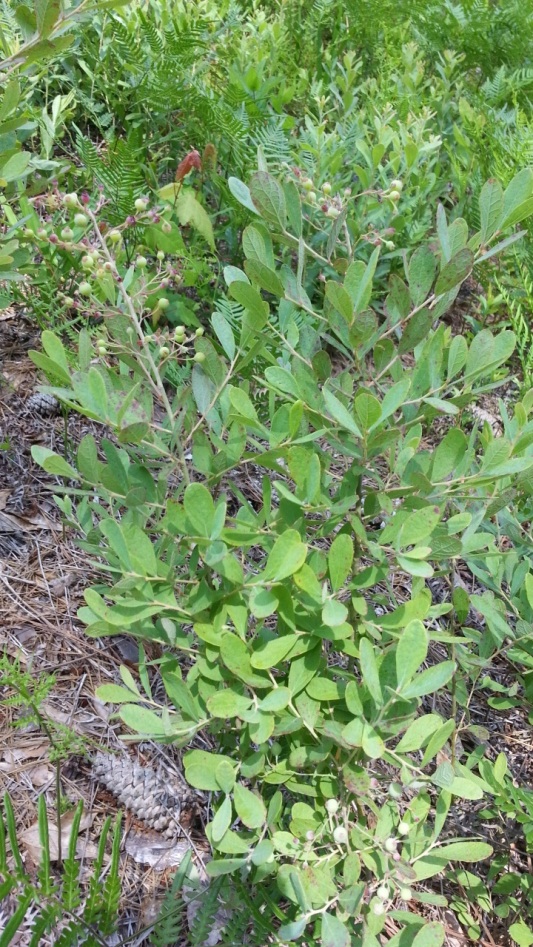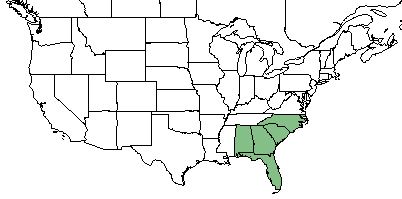Difference between revisions of "Gaylussacia tomentosa"
HaleighJoM (talk | contribs) (→Ecology) |
HaleighJoM (talk | contribs) (→Ecology) |
||
| Line 45: | Line 45: | ||
<!--===Pollination===--> | <!--===Pollination===--> | ||
<!--===Herbivory and toxicology===--> | <!--===Herbivory and toxicology===--> | ||
| − | <!--==Diseases and parasites==--> | + | <!--===Diseases and parasites===--> |
==Conservation, cultivation, and restoration== | ==Conservation, cultivation, and restoration== | ||
Latest revision as of 20:07, 30 June 2022
| Gaylussacia tomentosa | |
|---|---|

| |
| Photo by the [ Atlas of Alabama Plants Database] | |
| Scientific classification | |
| Kingdom: | Plantae |
| Division: | Magnoliophyta - Flowering plants |
| Class: | Magnoliopsida - Dicots |
| Order: | Ericales |
| Family: | Ericaceae |
| Genus: | Gaylussacia |
| Species: | G. tomentosa |
| Binomial name | |
| Gaylussacia tomentosa (A. Gray) | |

| |
| Natural range of Gaylussacia tomentosa from USDA NRCS Plants Database. | |
Common Name(s): hairytwig huckleberry[1], hairy dangleberry[2]
Contents
Taxonomic Notes
Synonym(s): Gaylussacia frondosa (Linnaeus) Torrey & A. Gray ex Torrey var. nana A. Gray; G. frondosa (Linnaeus) Torrey & A. Gray ex Torrey var. tomentosa A. Gray; Decachaena nana (A. Gray) Small.[3]
Varieties: none.[3]
Description
G. tomentosa is a dioecious perennial shrub that is a member of the Ericaceae family.[1] It grows low and spreads locally via underground stems. Leaves are 2.5-7 cm (1-2.8 in) long, leathery, oblong or elliptic, and obtuse and apiculate at the apex. Pedicels are 1-1.5 cm (0.39-0.59 in) long and the calyx is glabrous and about 3.5 mm (0.14 in) wide. It is typically found in sandy soils.[4]
Distribution
Its primary distribution extends north from central peninsular Florida to central Georgia and southern South Carolina and westward to southwestern Alabama.[1][2] Occurrences have also been reported in a southern county of North Carolina and a northern county in Georgia.[1]
Ecology
Habitat
This species inhabits pine flatwoods, sandhills, and xeric coastal fringe sandhills.[2] G. tomentosa has been observed in pine flatwoods, a thicket bordering a slough, along the edge of a pine-oak woodland, along an ecotone of a steephead bottom and adjacent slopes, in mesic woods, a pine-oak slope at the upper edge of wet-adapted plant species, and a semi-shaded gentle wood slope above a stream. Soils it has been observed to grow on include dry and moist loamy sand, and other loamy sands.[5] G. tomentosa has also been occasionally found in scrub and scrub flatwoods habitats.[6] It is also listed by the USDA Natural Resources Conservation Service as a facultative upland species, where it is most often found in upland non-wetland habitats but can occasionally be found in wetland habitats.[1]
Associated species include Illicium sp., Oxydendrum sp., Pinus palustris, and others.[5]
Phenology
G. tomentosa has been observed to flower from March through May.[2][7] Fruits mature afterwards from June through August[2][4] Fruiting has also been observed in April and May.[5]
Fire ecology
This species is commonly found in habitats that are frequently burned.[5] In Osceola National Forest, Florida, a burn frequency of 2 years yielded the greatest coverage of G. tomentosa, although it remained present in the 1 and 4 year fire interval treatments as well.[8]
Conservation, cultivation, and restoration
It global conservation status is apparently secure at G3G5, which is rounded to G4, due to its restricted distribution.[9]
Cultural use
Photo Gallery
References and notes
- ↑ 1.0 1.1 1.2 1.3 1.4 USDA, NRCS. (2016). The PLANTS Database (http://plants.usda.gov, 20 December 2017). National Plant Data Team, Greensboro, NC 27401-4901 USA.
- ↑ 2.0 2.1 2.2 2.3 2.4 Weakley A. S.(2015). Flora of the Southern and Mid-Atlantic States. Chapel Hill, NC: University of North Carolina Herbarium.
- ↑ 3.0 3.1 Weakley, A.S. 2015. Flora of the southern and mid-atlantic states. Working Draft of 21 May 2015. University of North Carolina at Chapel Hill, Chapel Hill, North Carolina.
- ↑ 4.0 4.1 Small J. K. (1897). Shrubs and trees of the southern states. –II. Bulletin of the Torrey Botanical Club. 24(9):437-445.
- ↑ 5.0 5.1 5.2 5.3 Florida State University Robert K. Godfrey Herbarium database. URL: http://herbarium.bio.fsu.edu. Last accessed: May 2019. Collectors: Loran C. Anderson, Mike Jenkins, Jeffrey M. Kane, Ed Keppner, Lisa Keppner, Helen Roth, and Annie Schmidt. States and Counties: Florida: Bay, Clay, Gadsden, Franklin, Leon, Liberty, and Okaloosa. Georgia: Thomas.
- ↑ Myers, J. H., and Richard P. Wunderlin (2003). "Vascular Flora of Little Manatee River State Park, Hillsborough County, Florida." Castanea 68(1): 56-74.
- ↑ Nelson, G. PanFlora: Plant data for the eastern United States with emphasis on the Southeastern Coastal Plains, Florida, and the Florida Panhandle. www.gilnelson.com/PanFlora/ Accessed: 20 DEC 2017
- ↑ Glitzenstein J. S., Streng D. R., and Wade D. D. (2003). Fire frequency effects on longleaf pine (Pinus palustris P. Miller) vegetation in South Carolina and northeast Florida, USA. Natural Areas Journal 23(1):22-37
- ↑ [[1]] NatureServe Explorer. Accessed: May 17, 2019